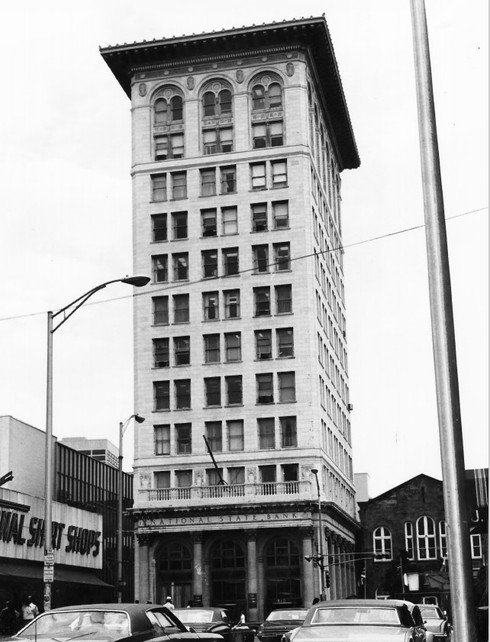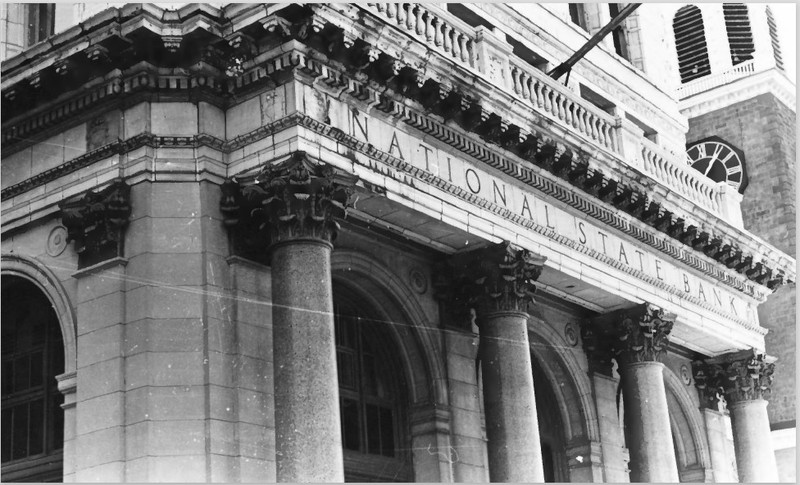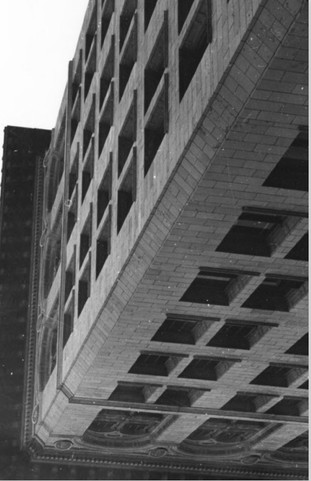First National State Bank
Introduction
Text-to-speech Audio
Images
Main facade of First National State Bank Building in 1976 photo (NRHP nom.)

1976 photo of detail of inscription and tops of columns on building front, view to SE (NRHP nom.)

View up to overhanging roofline in 1976 photo (NRHP nom.)

Backstory and Context
Text-to-speech Audio
The First National State Bank was chartered in New Jersey in 1812 as State Bank of Newark. Their first bank building, built in the same spot as the current building, resembled a house. The bank became a national bank in 1865. The bank was celebrating its 100th anniversary when the new building opened in 1912. A cornerstone laid on May 3, 1911 contains a time capsule with that day's local newspaper, photos of the bank's officers, and examples of early and modern currency. The entire first floor of the building was still being used as a bank in the mid-1970s, with a second floor overlooking the first. The other upper floors were organized with offices on one side and elevators and a meeting room on the opposite side.
The 90,000-square-foot building was designed by Cass Gilbert, known for designing a few other buildings you may have heard of - the U.S. Supreme Court Building in D.C. and the Woolworth Building in N.Y.C. Gilbert was one of the early pioneers of "skeleton construction" as used in the bank building, in which a primary steel frame directly supports exterior brick walls as a non-load-bearing cladding system. The original plans for the bank building on linen have been preserved by the New York Historical Society. The original plans showed that the second floor had originally been a mezzanine overlooking the first floor lobby; the space was later filled with steel and concrete to form a regular second floor. Viewed from the outside, the main block of the building is in three parts: a base (stories 1 and 2), a shaft (stories 3 to 10), and a capital (stories 11 and 12).
The building is part of the Four Corners commercial and business district, a neighborhood that has been undergoing renovation. The steel building is clad in concrete slabs; a three-story addition similar to the twelve-story main block predates a more recent four-story rear addition of steel, masonry block and brick holding an elevator and stairwell. To transform the building into a hotel, the developer hired Pennoni Associates Inc. The firm was tasked with designing two more stories atop the three-story addition, a nine-story elevator and stairwell addition to the rear (east) of the main block, and strengthening the roof to support a terrace. The new weight on the roof of the proposed terrace was engineered for by adding additional steel roof support beams between the existing, steel encased-in-concrete beams. In keeping with green building practices, solar panels were added above the roof's copper cornice. New luxury loft suites were built into the twelfth floor with metal floor decks and steel walls
The front desk of the Hotel Indigo is made from reclaimed bank teller desks. A glass mosaic tile mural by local artists tells the story of Thomas Edison working in the area to invent the stock ticker. Each of the 108 guest rooms come equipped with an iPad for ordering room service, housekeeping, or controlling the window shades. Exposed brick in the guest rooms helps to connect the building with its past. A coffee brand that has been in Newark for almost 150 years, TM Ward, developed a special blend for the hotel. The Ainsworth Rooftop Lounge in open to guests and locals, with views of the Manhattan skyline as you enjoy drinks or late-night snacks. The Edison Room holds meetings of up to 45 people. Paramount Hotel Group has managed the Hotel Indigo Newark Downtown since 2018. Prior to then, Crestline Hotels & Resorts, Inc. managed the hotel for the owners, The Hanini Group, LLC.
Sources
Deluca, John. Flock, Joseph. McDonald, Thomas. Kostrub, Nanci. NRHP Nomination of First National State Bank, Newark, N.J.. National Register. Washington, DC. National Park Service, 1976.
Emporis. Hotel Indigo Newark Downtown, Emporis, Buildings. Accessed January 18th 2021. https://www.emporis.com/buildings/121312/hotel-indigo-newark-downtown-newark-nj-usa.
Hotel Business. Hotel Indigo Newark Downtown Officially Opens, Hotel Business, HB on the Scene. March 27th 2015. Accessed January 18th 2021. https://www.hotelbusiness.com/hb-on-the-scene-hotel-indigo-newark-downtown-officially-opens/.
Mest, Elliot. Paramount Hotel Group to manage the Hotel Indigo in Newark, N.J., Hotel Management. May 31st 2018. Accessed January 18th 2021. https://www.hotelmanagement.net/operate/paramount-hotel-group-to-manage-hotel-indigo-newark-n-j.
Stuart, D. Matthew. The Transformation of the Historic First National State Bank Building: Newark New Jersey - Part 1, Structure Magazine. February 1st 2014. Accessed January 18th 2021. https://www.structuremag.org/?p=1549.
Stuart, D. Matthew. The Transformation of the Historic First National State Bank Building: Newark New Jersey - Part 2, Structure Magazine. March 1st 2014. Accessed January 18th 2021. https://www.structuremag.org/?p=1720.
https://npgallery.nps.gov/AssetDetail/NRIS/77000866
https://npgallery.nps.gov/AssetDetail/NRIS/77000866
https://npgallery.nps.gov/AssetDetail/NRIS/77000866
